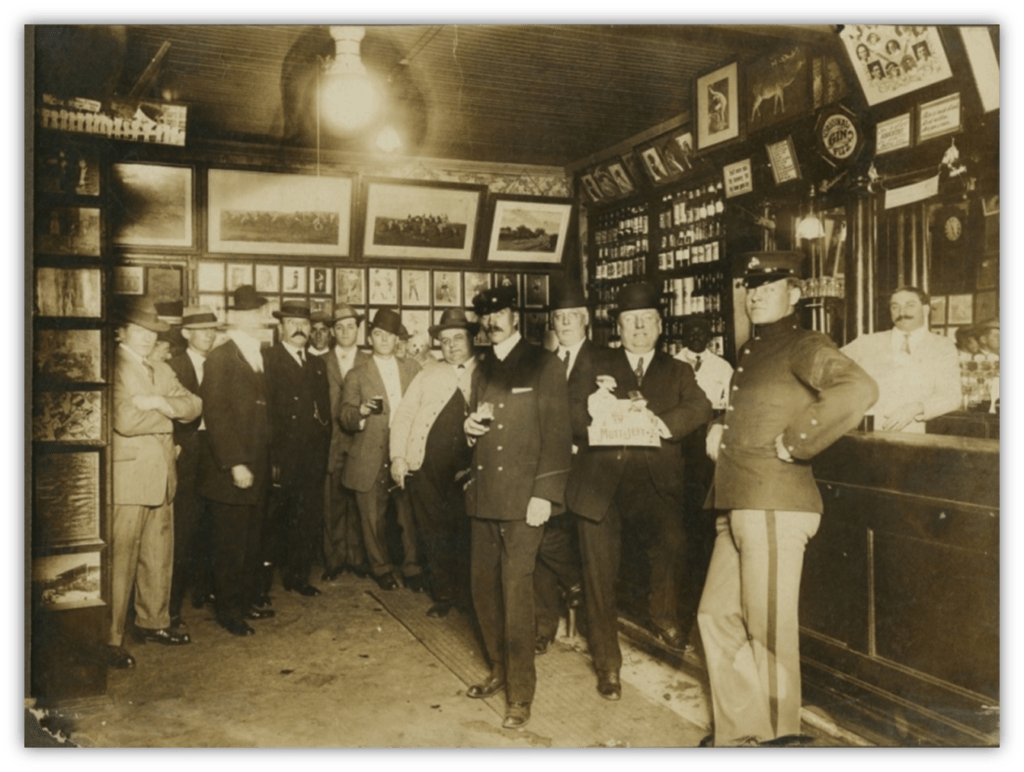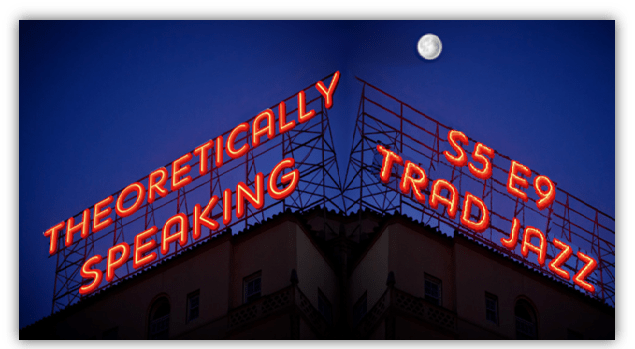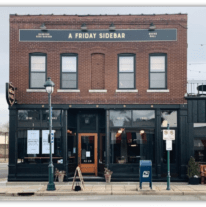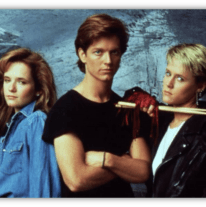Until very recently, science wasn’t sure what makes Jazz “swing.”
Not all Jazz has that rhythm, but it’s the swinging and swaying beat that makes early Jazz danceable.
Science, however, couldn’t describe it.

Musicians weren’t much help, offering not much more than, “It’s just the feel, man.” They knew how to swing but didn’t know what made the difference. It was just a mental switch they turned on.
People have tried charting the swinging feel. And the best they could come up with was quarter note triplets, but that’s not really it. Quarter note triplets are three notes played in the space of a single beat.

But plug it into a drum machine, and it doesn’t swing. So the quarter note triplet explanation isn’t right. Playing eighth notes right on the beat doesn’t explain it either. It’s somewhere in-between.
See? I can’t explain it better than any other musician. It’s just the feel, man.

“We came in second, after Genna Goldfarb’s Homemade Van deGraaff Generator.”
The missing ingredient was discovered in a study by physicists at the Max Planck Institute for Dynamics and Self-Organization in Göttingen, Germany.
They released their results in 2022.
To get that swinging feel, that “I know-it-when-I-hear-it” vibe, the rhythm section has to play on the beat – and the soloists have to play ever so slightly after the beat. How far after the beat depends on the song’s tempo.

But it’s about 9% of a quarter note.
We’re talking something less than 40 milliseconds. It’s so short that musicians didn’t know that’s what they were doing.
They just felt it.
That miniscule delay makes Jazz swing.
Traditional Jazz was the first form of Jazz, and we also call it Trad Jazz, Hot Jazz, New Orleans Jazz, and Dixieland. Some people don’t like calling it Dixieland because the word “Dixie” has a connection to slavery and the American Civil War. It wasn’t a divisive term in New Orleans but it was elsewhere, and still is, so I’ll err on the side of politeness.
Trad Jazz starts with a Story.
Sidney Story, to be precise.

He was a city alderman in New Orleans and in 1897, he led passage of an ordinance to set up a district for brothels and bars.
Not that he was in favor of prostitution. He simply recognized that all previous attempts to abolish it had failed. After all, where there’s a demand, there’s a supply.
His proposal was to set up a thirty-eight block area where brothels, saloons, and the like would be tolerated. Prostitution was still technically illegal, but so long as its practitioners stayed in that area, they wouldn’t be prosecuted.
At first, the area was called The District. It didn’t take long for people to start calling it Storyville. Alderman Story was not happy about that.

The bars and brothels hired local musicians to entertain their guests, and to keep the patrons spending money longer. A saying of the time was, “If the crowd don’t get laid, the band don’t get paid.”
Most of these musicians were black. They played Ragtime and the Jazz that had fairly recently been invented in Congo Square, as I covered in my Jazz installment.
Storyville’s establishments in the late 1800s and early 1900s are the When and Where of Trad Jazz’s invention.
The “Who” of it starts with Buddy Bolden.

He was a cornetist and bandleader, and is the first to combine Ragtime rhythm, Blues chords, the call and response from Spirituals, the verve of marching band music, and the improvisation of Jazz.
He made Jazz swing. He probably didn’t set out to create Trad Jazz, but there it is.
Bolden and his band are thought to have recorded a few wax cylinders but, if so, none have survived. We have no recordings of him at all, and we lost him early. Though he lived until 1931, he spent his last 24 years institutionalized for schizophrenia.

It’s now thought that he may have had pellagra, a disease that was common at the time among black people across the South. It’s brought on by poor nutrition, specifically a lack of vitamin B3, commonly known as niacin.
Take your vitamins, everyone.
So the first Jazz recording we still have is “Livery Stable Blues:”
By The Original Dixieland Jass Band, or ODJB.
There are two things to note here.

First is the spelling of “Jass.”
It was such a new word that the spelling hadn’t yet been agreed upon. There were several: Jass, Jas, Jasz, Jaz, and Jazz.
We’re not quite sure where the word came from, though some people think it’s sexual. Of course, some people think everything is sexual.

Another theory is that a French perfume company opened a shop in New Orleans and sold a popular jasmine scent. That might explain the “Jass” and “Jas” spellings.
The ODJB eventually changed their name to use the “Jazz” spelling, so some records have it one way and some the other. Nick LaRocca, who played trumpet in the band, said they changed it from Jass to Jazz “…because children and some adults could not resist the temptation to scratch the letter ‘J’ from the posters.” And who wants to be in The Original Dixieland Ass Band?
The second notable thing is that ODJB was white and from Chicago. This still causes consternation in some quarters. Jazz was created and perfected by black musicians. Why is the first Jazz record by whites?
Yes, record companies largely overlooked black artists, and it took them too many years to realize that black people bought records, too.

However, we think Buddy Bolden recorded those wax cylinders before the ODJB entered the studio, which would make him the first Jazz recording artist.
We know for sure the Versatile Four released “Down Home Rag” in 1916, a year before ODJB’s “Livery Stable Blues.” But most scholars say “Down Home Rag” is more Ragtime than Jazz, so they don’t count it as the first Jazz record.
The honor could have fallen to Freddie Keppard, a black New Orleans native.

He was renowned for his skill and charisma, and he actually performed “Livery Stable Blues” long before ODJB. He’s the one who added the barnyard animal noises to the song.
The Victor Talking Machine Company asked Keppard to record for them but he turned them down. He was afraid that would let other musicians “steal his stuff.” He eventually changed his mind, but ODJB was the first to perform Jazz on record.

At that time, New Orleans was one of the most peacefully desegregated cities in the country.
And there were integrated bands. Had ODJB been from there, their color might not matter, but they were from Chicago, which still has a white north side and a black south side. It doesn’t help that LaRocca made racist comments and claimed to have invented Jazz himself, with all evidence to the contrary.
Ragtime, like the Classical and Romantic piano pieces before it, was strictly structured. Ragtime pianists played what was written on the page and not much more. Trad Jazz kept Ragtime’s syncopated rhythm but threw the sheet music out the window.

If a band had a clarinet, a trumpet, and a trombone, one would play the main melody and the others would improvise over it, under it, and around it.
They’d all play at the same time, which, as we know from Baroque, is called polyphony, through the whole song. It’s a joyous sound.
Trad Jazz bands usually had five to eight players. Standard instruments were the clarinet, banjo, trumpet, trombone, sax, upright bass, drums, and/or piano. Maybe one or two of them might sing, too. Naturally, the fewer members in a band, the more each one could earn.

The clientele in Storyville was a mix of locals, military people stationed nearby, and tourists. Whether they were there for the alcohol or other flesh-based entertainment, the music was a hit, and the out-of-towners talked about it when they got home.
The word of mouth about all this debauchery explains, at least in part, how Jazz got its less than savory reputation. The great Duke Ellington said, “Jazz has always been like a man you wouldn’t want your daughter to associate with.”
Storyville had a history of violence. That seems to happen when law enforcement takes a hands off approach, especially around abundant alcohol. Just prior to World War I, four soldiers died in Storyville in separate incidents over the same week.
U.S. Secretary of War Newton D. Baker insisted the area be closed. He was concerned for his soldiers’ safety and morality. He didn’t say that troops must have high moral levels to go kill people, but he did say that strong morality was “armor.”

The city objected, as Storyville generated a lot of revenue. Mayor Martin Behrman said, “You can make it illegal, but you can’t make it unpopular,” but the city’s policy ended in 1917. Times were changing. Prohibition was only three years away.
Storyville’s glory days were over.
I don’t know what the newly unemployed prostitutes and bartenders did, but many of the musicians left town. Some took the train line north from New Orleans and found work in St. Louis and Chicago. Others went to New York City, which was a good choice because it’s New York City. Even then, it never slept.
Most of the musicians who went to St. Louis played on the riverboats.

They were required to play the hits of the day as written on the sheet music and at the prescribed tempo. No improvisation was allowed. We can’t really call it Jazz.
In the other cities, audiences liked the New Orleans sound. The stories of this lewd music only heightened interest in it. Forbidden fruit sells well.
Freddie Keppard was one of the musicians who settled in Chicago.

He was a popular sideman and led a band of his own. Contemporaneous accounts suggest he sounded a lot like Buddy Bolden, which lets us know what Bolden sounded like, but it’s also why he was considered talented but unoriginal.
Unfortunately, many of his recordings were from later in his life as those talents were declining.
Keppard often played with Jimmie Noone, first in New Orleans and then in Chicago. Noone proved inspirational to many, including Maurice Ravel, who based his “Boléro” on one of Noone’s improvisations, and Nat King Cole, who as a preteen would sneak out of the house to listen to Noone through the nightclub’s wall.

During WWII, Noone moved to Los Angeles. A Trad Jazz revival was in full swing, no pun intended, and Noone joined the Jazz band on The Orson Welles Almanac, a program on the Columbia Pacific Network, part of CBS radio. This band was one of the reasons for the revival.
He played four shows but on the morning of the fifth, April 29, 1944, he died of a heart attack. He was 48.

Welles asked the band’s trombonist, Kid Ory, to write a song to memorialize Noone. That very night, they played “Blues For Jimmie” for the first of many times.
It’s now considered a classic.
Saying there was a revival in the 1940s implies that Trad Jazz needed reviving.
It had actually faded about twenty years earlier, replaced by the subject of the next installment.
It never completely went away, however, and most of the better quality Trad Jazz recordings we have are from one revival or another.

As with Barbershop, its practitioners became whiter and its reputation became cleaner.
By the late 50s when the great Pete Fountain opened his Jazz club in New Orleans, it was a family friendly novelty.
We call it Traditional Jazz because it started everything, from the crooners of the 20s to the Bebop of the 40s to the Jazz Fusion of the 70s.
And without those things, we’d have no Doo Wop.
No Soul.
No Rock & Roll.
You’ll have a rollicking good time listening to Trad Jazz.
Just remember its place in history while you’re dancing.
Suggested Listening – Full YouTube Playlist

Down Home Rag
Versatile Four
1916

Livery Stable Blues
The Original Dixieland Jass Band
1917

Riverside Blues
King Oliver’s Creole Jazz Band
1923

Sweet Georgia Brown
Ben Bernie and His Hotel Roosevelt Orchestra
1925

Memphis Shake
Dixie Jug Blowers & Johnny Dodds
1926

Memphis Shake
Dixie Jug Blowers & Johnny Dodds
1926

New Orleans Bump
Jelly Roll Morton & His Orchestra
1929

You Rascal You
Jimmie Noone
1930

Chizzlin’ Sam
Clarence Williams
1935

Really The Blues
Tommy Ladnier and his Orchestra
1938

When The Saints Go Marching In
Louis Armstrong
1938

Blues For Jimmie
Kid Ory
1944

Shake It And Break It
Original Zenith Brass Band
1946

Tin Roof Blues
Sidney Brechet
1949

Brass Bell Blues
Firehouse Five Plus Two
1950
Let the author know that you liked their article with a “Green Thumb” Upvote!






Great stuff. And yes, this touches on some material that I had been covering, but not really. The origins of jazz are hard to write about, particularly because the most crucial innovators, like Bolden, don’t have surviving records of their music for us to appreciate. Going from records alone, it would be easy to assume that white people invented jazz.
One thing I recently learned is that the song “Funky Butt” was originally written by Bolden. Jelly Roll Morton later recorded it as “I Thought I Heard Buddy Bolden Say.” I first heard it via Mississippi John Hurt’s 1960 recording:
https://www.youtube.com/watch?v=RA9I3rrHly8
Agreed on all counts. I nearly included “Funky Butt.” And now I can’t remember why I didn’t. I think it was because I couldn’t find a decent early recording. Love me some Mississippi John Hurt though.
I’m not expert enough to know how closely it adhered to the original trad jazz movement but I’m aware that there was the incongruity here of early rock n roll being accompanied by a trad jazz revival. It lasted from the mid 50s through to the early 60s, another casualty of the beat boom. The Temperance Seven had a #1 in 1961 with You’re Driving Me Crazy (produced by George Martin), they were more on the humorous side rather than the traditional – a precursor to Bonzo Dog Doo-Dah Band by the looks of this performance. Amongst others there was #1 alumni Acker Bilk and then Kenny Ball And His Jazzmen who racked up an impressive 13 top 40 hits between ’61 and ’64.
Bizarre to look back now and see that amidst the excitement of early rock and roll and even into the first couple of years of The Beatles success, they were sharing the limelight with trad jazz.
https://youtu.be/cz_2Lekc098?feature=shared
Yes, and really odd to think the The Who, know for volume and smashing instruments, started as a Trad Jazz band.
I hadn’t heard of The Temperance Seven. Really fun clip!
I thought Queen invented Jazz in 1978.
…and In Only Seven Days.
There is only one kind of jazz, and that’s traditional jazz; that’s the vibe I get from Winston Marsalis. To confirm, I looked it up. But I vividly recall Winston being upset with his younger brother Branford for “selling out” the genre by taking The Tonight Show gig. So I guess Marsalis isn’t a big Spyro Gyra fan. Or champions Bitches Brew, my introductory jazz album. To Winston and his ilk, Miles Davis must be the ultimate Jazz Butcher. Pat Fish. RIP.
Great article, V-dog. I had no idea how to comment on zydeco. But I read it.
Thanks, cappie. Comments aren’t necessary for Zydeco, but dancing is.
I always knew this subgenre as Dixieland Jazz and never heard the term Trad Jazz before this column. This seems like an unnecessary name change, IMO.
It’s certainly the better known name, and I could have erred that way, too. It was a coin flip.